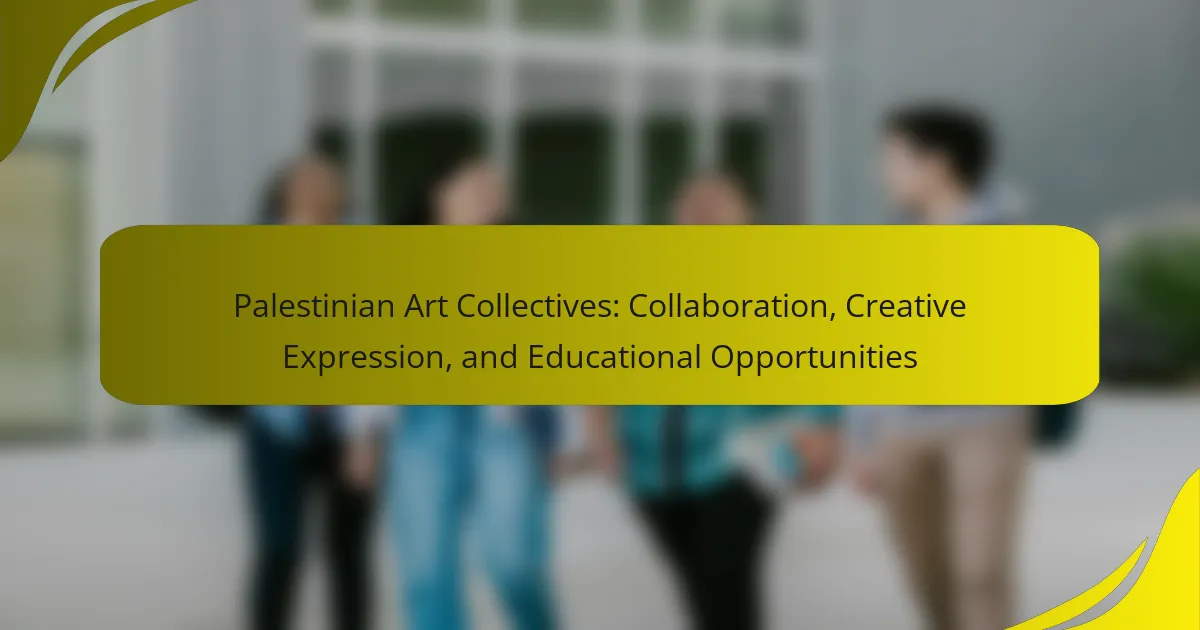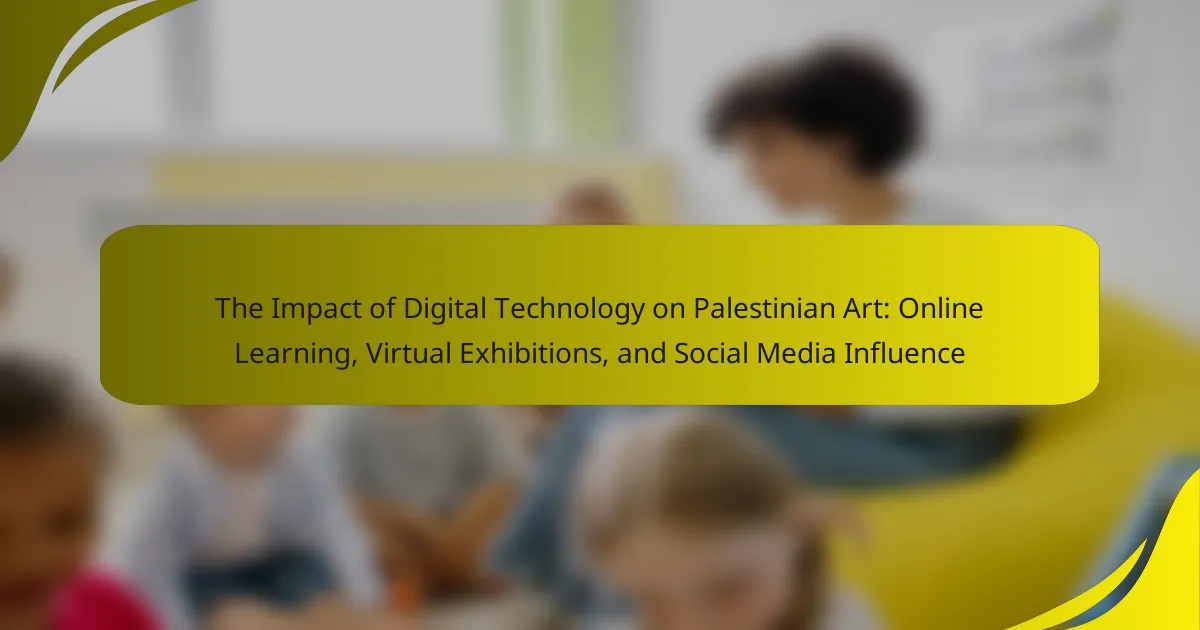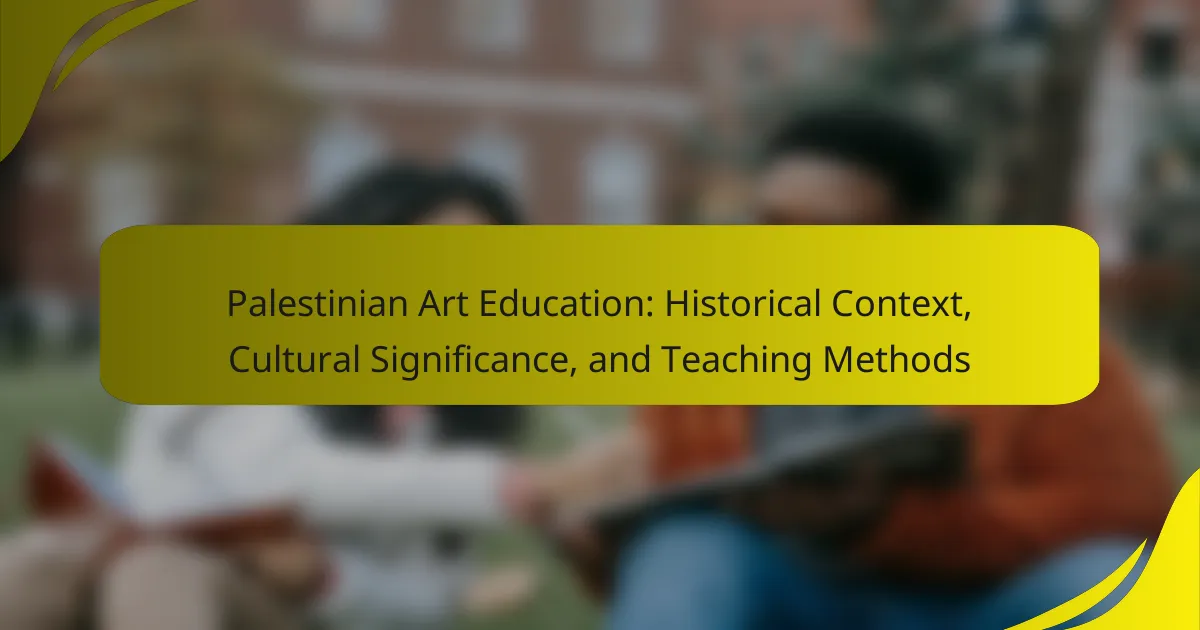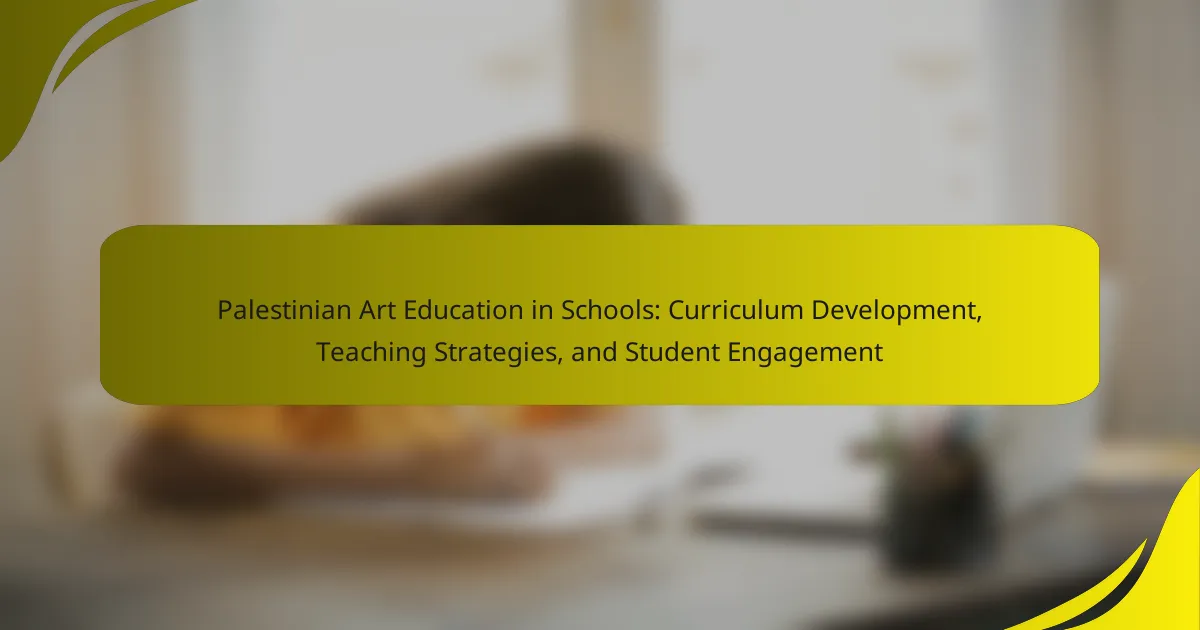The article examines the influence of global art movements—specifically modernism, postmodernism, and contemporary art—on Palestinian art education. It highlights how these movements shape artistic identity, cultural narratives, and social themes within Palestinian institutions. The article addresses the challenges faced in integrating these global influences, including limited resources, political instability, and economic constraints. Additionally, it explores emerging innovations in art education, such as the use of digital media and collaborations with international artists, which aim to enhance accessibility and foster community engagement. Overall, the discussion reveals the dynamic interplay between global trends and local artistic practices in Palestinian art education.
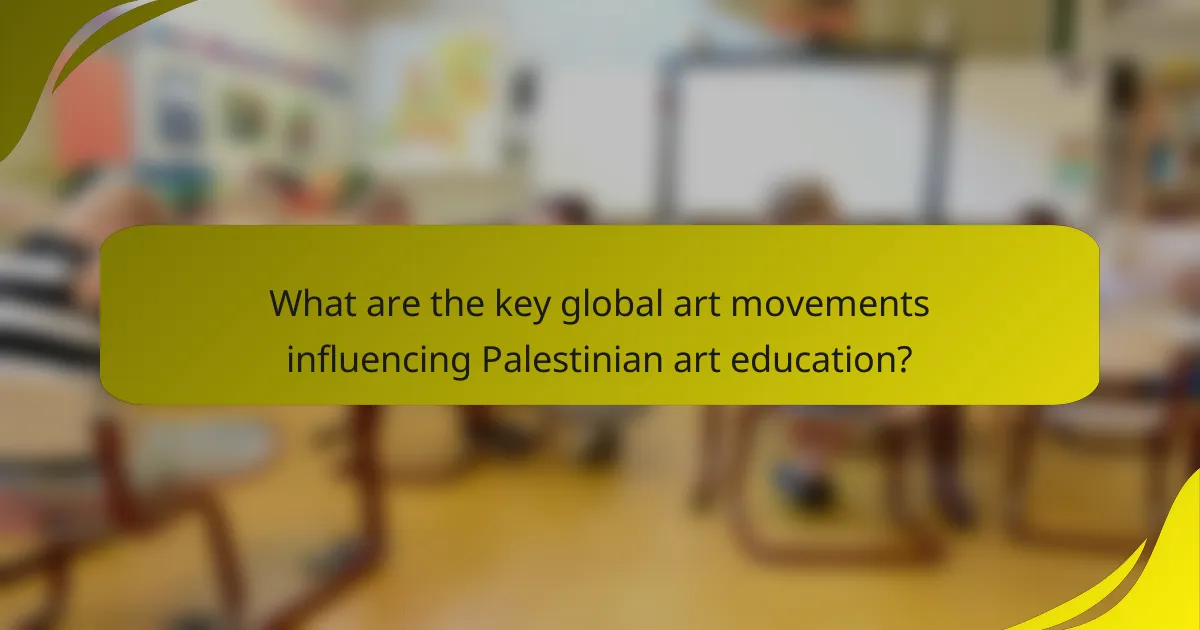
What are the key global art movements influencing Palestinian art education?
Key global art movements influencing Palestinian art education include modernism, postmodernism, and contemporary art. Modernism introduced new forms and ideas that encouraged Palestinian artists to explore identity and cultural narratives. Postmodernism challenged traditional boundaries, allowing for diverse expressions in Palestinian art. Contemporary art movements emphasize social and political themes, resonating with the Palestinian experience. These movements provide frameworks for artists to engage with global dialogues while addressing local issues. The impact of these movements is evident in art programs and curricula across Palestinian institutions. They foster critical thinking and creativity among students, preparing them for a global art landscape.
How do these art movements shape artistic expression in Palestine?
Art movements shape artistic expression in Palestine by introducing diverse styles and concepts. These movements influence local artists to explore new themes and techniques. For instance, the global rise of modernism encourages experimentation with form and color. Additionally, movements like surrealism resonate with Palestinian artists, reflecting their complex realities. The incorporation of social and political themes is evident in contemporary works. Artists often use their art as a form of resistance and identity assertion. Global art movements also foster collaboration and dialogue among Palestinian artists. This exchange enriches the local art scene and promotes cultural awareness. Overall, these influences create a dynamic artistic landscape in Palestine.
What specific characteristics of global art movements resonate with Palestinian artists?
Palestinian artists resonate with characteristics of global art movements such as social activism, identity exploration, and cultural hybridity. Social activism in art movements, like Dada and Feminism, inspires Palestinian artists to express resistance and resilience. Identity exploration, seen in movements like Postmodernism, encourages artists to reflect on their cultural narratives. Cultural hybridity, prominent in contemporary art, allows Palestinian artists to blend traditional and modern elements. These characteristics provide a platform for Palestinian artists to convey their unique experiences and struggles. The emphasis on these traits aligns with the broader context of global art, enhancing the visibility of Palestinian narratives.
How do historical contexts of these movements relate to Palestinian art?
Historical contexts of global art movements significantly influence Palestinian art. These movements provide frameworks for expression and resistance. For instance, the modernist movement in the early 20th century inspired Palestinian artists to explore new forms and techniques. The political turmoil and displacement faced by Palestinians shaped their artistic narratives. Movements like post-colonialism resonate deeply in their work, reflecting struggles for identity and autonomy. The influence of international art events, such as the Venice Biennale, has also introduced Palestinian art to global audiences. This exposure fosters dialogue about the socio-political conditions in Palestine. Overall, historical contexts enrich the narrative and depth of Palestinian art.
What trends are emerging in Palestinian art education as a result of global influences?
Emerging trends in Palestinian art education reflect increased global influences. There is a growing incorporation of contemporary art practices. This includes the use of digital media and technology in art creation. Collaborative projects with international artists are becoming more common. These projects enhance cross-cultural exchanges and learning opportunities. Additionally, critical theory and social issues are being integrated into the curriculum. This approach encourages students to engage with global dialogues. Workshops and residencies featuring global artists are also on the rise. Such initiatives expand the skill sets and perspectives of Palestinian art students.
Which contemporary art practices are being adopted in Palestinian educational institutions?
Palestinian educational institutions are adopting various contemporary art practices. These practices include participatory art, community-based projects, and digital storytelling. Participatory art engages students in collaborative creation processes. Community-based projects focus on social issues relevant to Palestinian society. Digital storytelling allows students to express their narratives through multimedia. Workshops and exhibitions are frequently organized to showcase student work. These initiatives reflect the influence of global art movements. They aim to foster critical thinking and cultural expression among students.
How are these trends reflected in student projects and exhibitions?
Student projects and exhibitions reflect trends in Palestinian art education by incorporating global art movements. Students often blend traditional Palestinian themes with contemporary techniques. This fusion showcases a dialogue between local identity and international influences. For instance, projects may use mixed media to address social issues, mirroring global trends in activism through art. Exhibitions frequently highlight collaborative works, emphasizing community engagement. The use of digital platforms for showcasing art aligns with global shifts towards online visibility. Additionally, students experiment with diverse materials, reflecting sustainability trends seen in global art practices. These elements demonstrate how Palestinian art education is evolving in response to worldwide artistic currents.
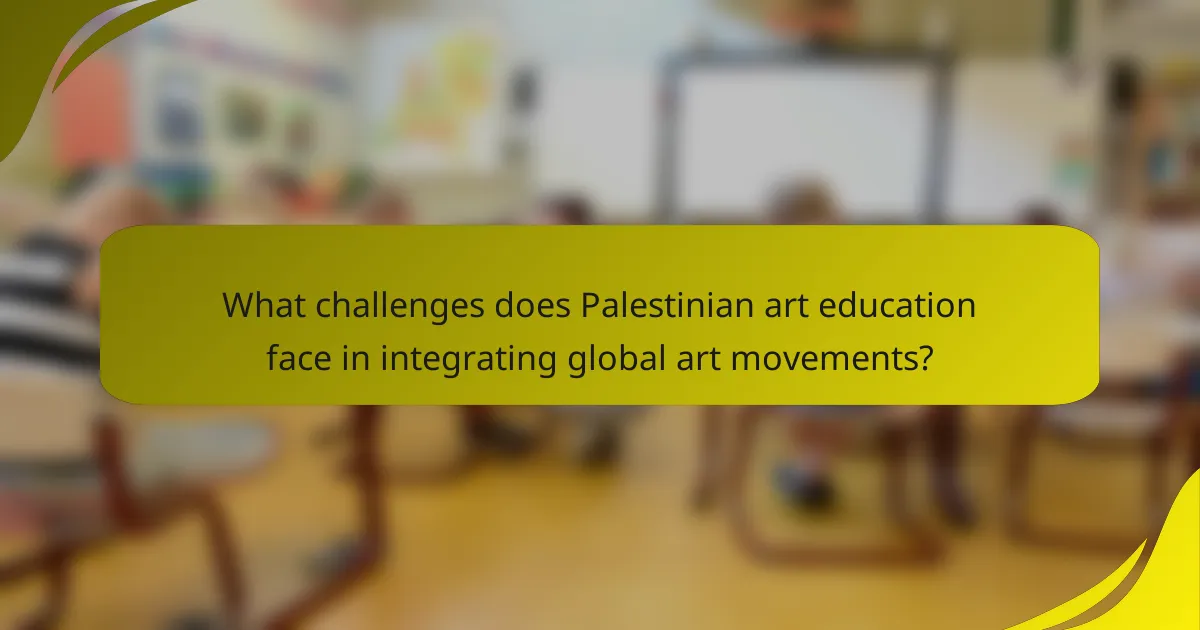
What challenges does Palestinian art education face in integrating global art movements?
Palestinian art education faces several challenges in integrating global art movements. Limited access to resources hampers exposure to contemporary global practices. Political instability restricts movement and collaboration with international artists. Cultural identity concerns arise as educators balance local traditions with global influences. Economic constraints limit funding for art programs and materials. Additionally, there is a lack of trained educators familiar with global art trends. This combination of factors creates significant barriers to effectively incorporating global art movements into Palestinian art education.
What socio-political factors impact the incorporation of global art influences?
Socio-political factors significantly impact the incorporation of global art influences. Political stability affects artists’ ability to access international art movements. Economic conditions determine funding and resources available for art education. Cultural policies can promote or restrict the integration of global influences into local art practices. Social movements often inspire artists to engage with global themes, reflecting local issues. For instance, the Palestinian struggle for identity influences how global art is interpreted locally. Government censorship may limit exposure to certain global art trends. International collaborations can enhance the exchange of ideas but may be hindered by geopolitical tensions. Overall, these factors shape the dialogue between local and global art contexts.
How does the political situation in Palestine affect art curricula?
The political situation in Palestine significantly impacts art curricula. Restrictions on movement and access to resources limit educational opportunities. Art educators often face censorship and pressure from authorities. This environment influences the themes and subjects taught in art classes. Many curricula focus on social justice and resistance. Students are encouraged to express their identity and experiences through art. Additionally, the lack of funding affects the availability of materials and facilities. Historical events, such as the Nakba, are often integrated into art education to foster awareness. These factors collectively shape a unique and resilient art curriculum in Palestine.
What barriers do educators encounter when introducing global art concepts?
Educators encounter several barriers when introducing global art concepts. Limited access to resources is a significant challenge. Many educators lack materials that showcase diverse global art forms. Cultural biases can hinder the incorporation of non-Western art perspectives. Educators may also face resistance from students or parents who prefer traditional local art. Additionally, inadequate training in global art education can limit teachers’ confidence. Time constraints in the curriculum often restrict the exploration of global concepts. Finally, language barriers can complicate discussions about global art influences. These challenges collectively impact the effectiveness of global art education.
How does the lack of resources hinder art education in Palestine?
The lack of resources significantly hinders art education in Palestine. Insufficient funding limits access to quality materials and facilities. Many schools lack basic art supplies such as paints, brushes, and canvases. This scarcity restricts students’ ability to explore creativity and develop skills. Additionally, inadequate training for art teachers affects the quality of instruction. Limited exposure to diverse art forms and techniques stifles artistic growth. The ongoing political situation exacerbates these challenges, further limiting opportunities for workshops and exhibitions. Consequently, students miss out on crucial experiences that foster artistic expression and cultural appreciation.
What are the implications of limited access to materials and facilities?
Limited access to materials and facilities hinders the development of artistic skills in Palestinian art education. This restriction affects the quality of education that students receive. Without adequate resources, students struggle to experiment with different techniques. The lack of facilities limits opportunities for hands-on learning and collaboration. Consequently, creativity and innovation may be stifled among emerging artists. Research indicates that access to diverse materials enhances artistic expression. In regions with limited resources, students often rely on makeshift tools, which can impede their artistic growth. Overall, the implications are significant, impacting both individual artists and the broader art community.
How do financial constraints affect the quality of art education?
Financial constraints significantly reduce the quality of art education. Limited funding leads to inadequate resources such as art supplies, facilities, and technology. Many art programs face budget cuts, resulting in fewer classes and reduced teaching staff. This directly impacts the student-to-teacher ratio, hindering personalized instruction. Financial limitations also restrict access to field trips and workshops that enhance learning. Consequently, students miss opportunities to engage with professional artists and diverse artistic practices. According to a report by the National Art Education Association, schools with higher funding provide more comprehensive art programs and better student outcomes. Thus, financial constraints create a cycle of diminished educational quality in the arts.
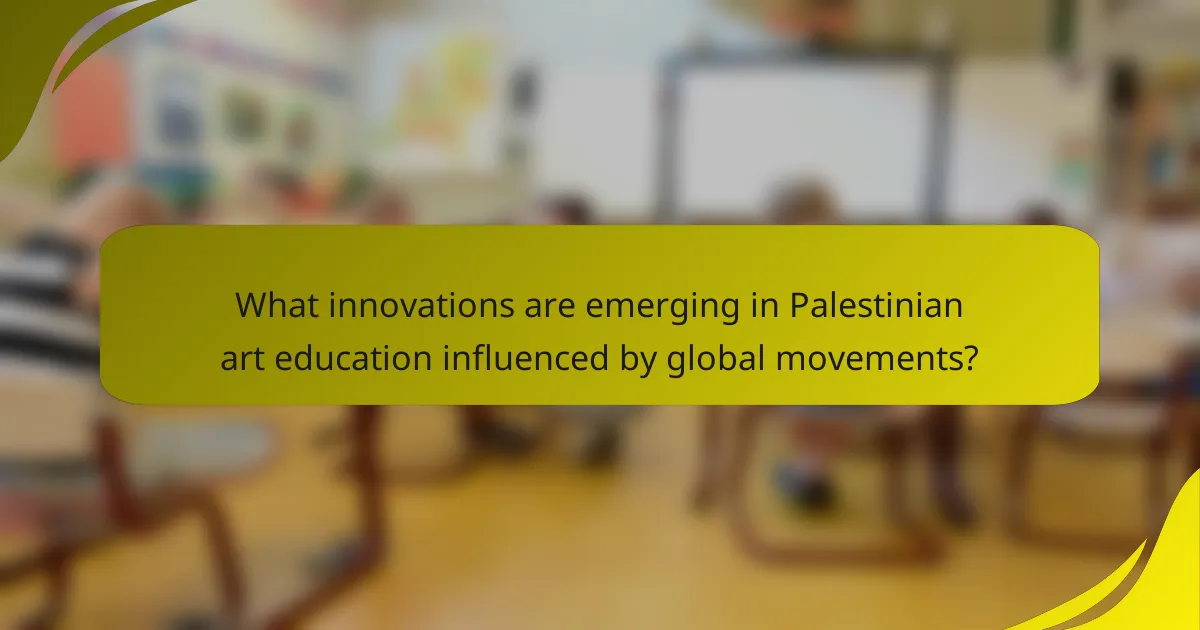
What innovations are emerging in Palestinian art education influenced by global movements?
Emerging innovations in Palestinian art education influenced by global movements include the integration of digital media and technology. Art institutions are adopting online platforms for teaching and showcasing student work. This shift enhances accessibility and broadens participation. Collaborations with international artists introduce new techniques and perspectives. These partnerships foster cross-cultural exchanges and enrich the curriculum. Additionally, the incorporation of social activism into art education reflects global trends. Students are encouraged to address local issues through their art. This approach empowers them to engage with their communities. Overall, these innovations reflect a dynamic response to global artistic influences.
How are technology and digital platforms reshaping art education in Palestine?
Technology and digital platforms are significantly reshaping art education in Palestine. They provide new avenues for artistic expression and learning. Online resources enhance accessibility to global art movements and techniques. Virtual workshops connect Palestinian artists with international mentors. Social media platforms promote visibility for local artists. Digital tools facilitate collaborative projects across geographical boundaries. This shift allows for a more diverse curriculum that incorporates contemporary practices. Evidence of this transformation can be seen in increased participation in online art exhibitions and digital art classes.
What role do online art communities play in Palestinian art education?
Online art communities significantly enhance Palestinian art education by providing access to diverse resources and networks. These platforms facilitate collaboration among artists and educators, fostering creative exchange. They also offer exposure to global art trends and techniques, enriching local artistic practices. Furthermore, online communities serve as spaces for critique and feedback, helping Palestinian artists refine their skills. Accessibility to online workshops and tutorials broadens educational opportunities. This democratization of art education empowers individuals who may lack formal training. Overall, online art communities play a crucial role in shaping and supporting Palestinian art education.
How are educators leveraging social media to promote Palestinian art?
Educators are leveraging social media to promote Palestinian art by creating online platforms for visibility. They share artworks, artist profiles, and cultural narratives through various social media channels. This approach increases engagement with wider audiences beyond traditional galleries. Educators also use hashtags to connect with global art movements and communities. These strategies foster collaboration among artists, educators, and students. Social media campaigns often highlight historical and contemporary issues in Palestinian art. This method helps raise awareness and appreciation for the cultural significance of the art. Studies show that social media can enhance the reach of educational initiatives in the arts.
What collaborative projects exist between Palestinian and global art educators?
Collaborative projects between Palestinian and global art educators include various initiatives aimed at cultural exchange and artistic development. One notable project is the “Art for Peace” initiative, which connects Palestinian artists with international educators to foster dialogue through art. Another example is the “Creative Palestine” program, which partners Palestinian art institutions with global art schools for joint workshops and exhibitions. The “International Art Education Exchange” project facilitates the sharing of teaching methodologies and resources between Palestinian and global educators. These projects aim to enhance artistic skills and promote cultural understanding. They also address the challenges faced by Palestinian artists in a global context.
How do these collaborations enhance the learning experience for students?
Collaborations enhance the learning experience for students by providing access to diverse perspectives. These partnerships often include artists, educators, and cultural institutions. They introduce students to global art movements and techniques. Exposure to different methodologies fosters creativity and critical thinking. Collaborative projects encourage hands-on learning and practical application of skills. Students benefit from mentorship opportunities offered through these collaborations. Research indicates that collaborative learning can improve engagement and retention rates. For instance, studies show that students involved in collaborative projects score higher on assessments.
What are some successful case studies of international partnerships in art education?
Several successful case studies exist in international partnerships in art education. One notable example is the collaboration between the University of the Arts London and Al-Quds University. This partnership focused on developing art curricula that incorporate both Western and Palestinian perspectives. The program facilitated student exchanges and joint exhibitions, enhancing cultural understanding.
Another case study is the partnership between the Art Institute of Chicago and the Palestinian Museum. This collaboration involved workshops and exhibitions showcasing Palestinian artists. It aimed to promote Palestinian art on an international platform.
The Global Arts and Education Initiative is also significant. It connects institutions worldwide to foster artistic dialogue and educational exchange. This initiative has successfully implemented projects in various countries, including Palestine.
These case studies demonstrate the effectiveness of international partnerships in enriching art education. They highlight the potential for cross-cultural collaboration to enhance artistic practices and educational outcomes.
What best practices can be adopted for integrating global art movements into Palestinian art education?
Adopting best practices for integrating global art movements into Palestinian art education involves several strategies. First, educators should incorporate diverse art styles and techniques from global movements into the curriculum. This can enhance students’ creativity and broaden their artistic perspectives. Second, collaboration with international artists can provide students with firsthand experience and insights. Workshops and guest lectures can facilitate this exchange. Third, integrating technology can help students access global art resources and platforms. Online exhibitions and virtual tours can expose them to various art movements. Fourth, fostering critical discussions about the socio-political contexts of global art can deepen students’ understanding. This encourages them to reflect on their own cultural identity. Lastly, establishing partnerships with global art institutions can provide opportunities for student exchanges and collaborative projects. These practices can enrich Palestinian art education by creating a more inclusive and expansive learning environment.
What strategies can educators implement to overcome challenges?
Educators can implement collaborative learning strategies to overcome challenges. Collaborative learning fosters teamwork among students. This approach encourages diverse perspectives and enhances problem-solving skills. Additionally, educators can integrate technology into the curriculum. Technology facilitates access to global art movements and resources. It also allows for innovative teaching methods, such as virtual art exhibitions. Professional development for educators is crucial as well. Training helps teachers stay updated on new trends and methodologies. Finally, building community partnerships can provide additional resources and support. These partnerships can enhance art education by connecting students with local artists and initiatives.
How can community involvement enhance art education initiatives?
Community involvement can significantly enhance art education initiatives by fostering collaboration and resource sharing. Engaging local artists and organizations provides students with diverse perspectives and mentorship opportunities. This interaction enriches the curriculum with real-world applications of art. Community events and exhibitions can showcase student work, boosting confidence and visibility. Studies show that schools with strong community ties have higher student engagement and achievement in the arts. For example, the National Endowment for the Arts reported that community arts programs increase participation and improve educational outcomes. Overall, active community participation creates a supportive environment that nurtures artistic development.
The main entity of this article is Palestinian art education and its relationship with global art movements. The article examines key influences such as modernism, postmodernism, and contemporary art, highlighting how these movements shape artistic expression, curricula, and trends within Palestinian institutions. It addresses challenges faced in integrating global influences, including limited resources and socio-political factors, while also exploring emerging innovations like digital media and collaborative projects. The discussion includes best practices for enhancing art education through community involvement and international partnerships, ultimately emphasizing the dynamic interplay between local identity and global artistic currents.
